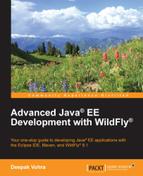The objective of the EJB 3.x specification is to simplify its development by improving the EJB architecture. This simplification is achieved by providing metadata annotations to replace XML configuration. It also provides default configuration values by making entity and session beans POJOs (Plain Old Java Objects) and by making component and home interfaces redundant. The EJB 2.x entity beans is replaced with EJB 3.x entities. EJB 3.0 also introduced the Java Persistence API (JPA) for object-relational mapping of Java objects.
WildFly 8.x supports EJB 3.2 and the JPA 2.1 specifications from Java EE 7. While EJB 3.2 is supported, the sample application in this chapter does not make use of the new features of EJB 3.2 (such as the new TimerService API and the ability to disable passivation of stateful session beans). The sample application is based on Java EE 6 and EJB 3.1. The configuration of EJB 3.x with Java EE 7 is also discussed, and the sample application can be used or modified to run on a Java EE 7 project. We have used a Hibernate 4.3 persistence provider. Unlike some of the other persistence providers, the Hibernate persistence provider supports automatic generation of relational database tables, including the joining of tables.
In this chapter, we will create an EJB 3.x project and build and deploy this project to WildFly 8.1 using Maven. This chapter has the following sections:
- Setting up the environment
- Creating a WildFly runtime
- Creating a Java EE project
- Configuring a data source with MySQL database
- Creating entities
- Creating a JPA persistence configuration file
- Creating a Session Bean Facade
- Creating a JSP client
- Configuring the
jboss-ejb3-ejbsubproject - Configuring the
jboss-ejb3-websubproject - Configuring the
jboss-ejb3-earsubproject - Deploying the EAR Module
- Running the JSP Client
- Configuring a Java EE 7 Maven Project
We need to download and install the following software:
- WildFly 8.1.0.Final: Download
wildfly-8.1.0.Final.zipfrom http://wildfly.org/downloads/. - MySQL 5.6 Database-Community Edition: Download this edition from http://dev.mysql.com/downloads/mysql/. When installing MySQL, also install Connector/J.
- Eclipse IDE for Java EE Developers: Download Eclipse Luna from https://www.eclipse.org/downloads/packages/release/Luna/SR1.
- JBoss Tools (Luna) 4.2.0.Final: Install this as a plug-in to Eclipse from the Eclipse Marketplace (http://tools.jboss.org/downloads/installation.html). The latest version from Eclipse Marketplace is likely to be different than 4.2.0.
- Apache Maven: Download version 3.05 or higher from http://maven.apache.org/download.cgi.
- Java 7: Download Java 7 from http://www.oracle.com/technetwork/java/javase/downloads/index.html?ssSourceSiteId=ocomcn.
Set the environment variables: JAVA_HOME, JBOSS_HOME, MAVEN_HOME, and MYSQL_HOME. Add %JAVA_HOME%/bin, %MAVEN_HOME%/bin, %JBOSS_HOME%/bin, and %MYSQL_HOME%/bin to the PATH environment variable. The environment settings used are C:wildfly-8.1.0.Final for JBOSS_HOME, C:Program FilesMySQLMySQL Server 5.6.21 for MYSQL_HOME, C:mavenapache-maven-3.0.5 for MAVEN_HOME, and C:Program FilesJavajdk1.7.0_51 for JAVA_HOME. Run the add-user.bat script from the %JBOSS_HOME%/bin directory to create a user for the WildFly administrator console. When prompted What type of user do you wish to add?, select a) Management User. The other option is b) Application User.
Management User is used to log in to Administration Console, and Application User is used to access applications. Subsequently, specify the Username and Password for the new user. When prompted with the question, Is this user going to be used for one AS process to connect to another AS..?, enter the answer as no. When installing and configuring the MySQL database, specify a password for the root user (the password mysql is used in the sample application).
